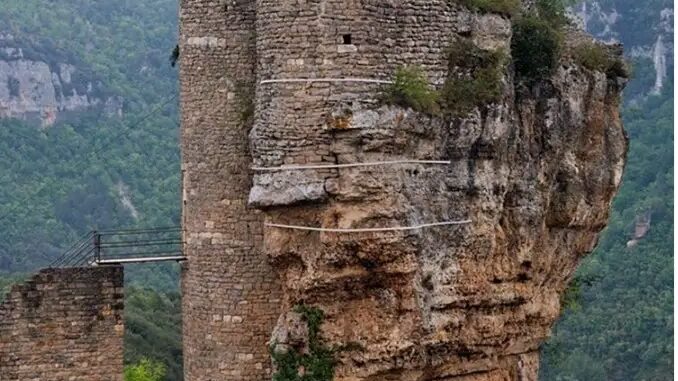
Built in the 12th century, Château de Peyrelade stands as a striking monument to medieval ingenuity and regional history in southern France. Perched dramatically on a natural rock outcrop in the Aveyron region, the fortress has long captured the imagination of historians, tourists, and local communities alike.*
**A Strategic Stronghold in Medieval France**
Constructed during the tumultuous 12th century, Château de Peyrelade was more than just a defensive structure; it was a vital regional hub that played a key role in the defense of the Rouergue area. Its strategic location at the entrance to the Gorges du Tarn allowed it to control critical trade routes and serve as a bulwark against invading forces. The name “Pèira Lada,” derived from the Occitan language meaning “wide rock,” perfectly encapsulates the fortress’s defining feature: its integration into the natural landscape, utilizing the sheer cliff face as one of its defensive walls.
Throughout the Middle Ages, Peyrelade functioned as a linchpin in local defense. It housed garrisons, provided refuge during sieges, and symbolized the power and prestige of the local lords. Its commanding position allowed defenders to monitor and control movements through the rugged terrain, making it nearly impregnable. The fortress’s architecture, with towers and curtain walls seamlessly clinging to the rocky outcrop, exemplifies medieval military engineering aimed at maximizing natural defenses.
**Architectural Marvel and Natural Fortress**
What sets Peyrelade apart from many medieval castles is its harmonious integration with the landscape. The natural cliff face forms one side of the fortress, eliminating the need for construction on that front and creating a nearly impregnable barrier. Constructed elements, including towers, ramparts, and inner buildings, appear as natural extensions of the rock itself. This unique design not only enhanced its defensive capabilities but also exemplified the ingenuity of medieval builders.
The fortress’s layout was carefully designed to optimize defense and functionality. Narrow passageways, crenellated walls, and strategically placed towers allowed defenders to repel attackers effectively. Over centuries, modifications and additions reflected changing military tactics and the needs of its occupants.
**Decline and Ruin**
The fortunes of Château de Peyrelade declined in the wake of regional conflicts and religious upheavals. The Wars of Religion in the 16th century, marked by widespread violence between Catholics and Protestants, inflicted significant damage on many castles throughout France, including Peyrelade. The fortress was eventually abandoned and fell into disrepair.
By the 17th century, the fortress was dismantled as part of broader efforts to reduce the power of feudal lords and prevent rebellious strongholds. Its stones and structures were repurposed elsewhere, leaving behind a haunting but evocative ruin that still hints at its former grandeur.
**A Heritage Site and Tourist Attraction**
Today, Château de Peyrelade stands as a testament to medieval military architecture and regional history. Although only fragments remain, careful restoration efforts have allowed visitors to explore reconstructed elements, walk along crumbling ramparts, and imagine the fortress’s former might.
Visitors are rewarded with sweeping panoramic views of the surrounding landscape, including the rugged Gorges du Tarn and the rolling countryside of Aveyron. The site offers a tangible connection to medieval frontier life, providing insights into the strategic importance of such fortresses and the lives of those who built and defended them.
Educational programs, guided tours, and preservation initiatives continue to highlight Peyrelade’s significance, attracting history enthusiasts, hikers, and families alike. The castle’s dramatic setting and rich history make it a must-visit destination for anyone interested in France’s medieval past.
**Looking to the Future**
Efforts to preserve and promote Château de Peyrelade are ongoing, recognizing its importance as a cultural and historical landmark. Scholars continue to study its construction and role within the regional defense network, while local authorities aim to enhance visitor experiences through improved access and interpretive materials.
As a symbol of resilience and ingenuity, Peyrelade not only tells the story of medieval warfare and regional power but also serves as a reminder of the enduring human capacity to adapt and thrive amid challenging landscapes. Its dramatic cliffs and ancient stones continue to inspire awe and curiosity, ensuring that the fortress remains a cherished part of France’s medieval heritage for generations to come.
Leave a Reply